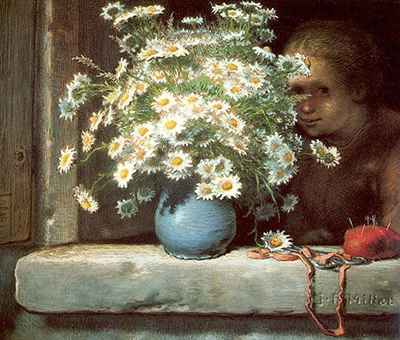While most of Jean Francois Millet's work was themed strongly around the serious business of agriculture – understandably given his being born into a farming family and helping his father with that business from a fairly early age – he was never averse to seeing the beauty in the world around him: such as here in a simple vase of daisies.
The Bouquet of Margueritas is a deceptively simple image: a large vase of white daisies with yellow middles sits on a window sill: the eye of the viewer is outside the room – as are the daisies! – while shadowed inside the room a face peers out through the flowers with a rather mischievous and knowing expression.
The simplicity is deceptive as the longer one examines the image, the more one sees. Millet has accurately rendered the difference between the old stone sill upon which the blue vase sits, and the wooden frame of the window which provides an effective double frame for the flowers and the half-hidden girl. That it is a girl can be surmised, partially by her semi-concealed stance, but mostly from the sewing paraphernalia placed on the convenient windowsill, next to the vase. Next, in fact, to a fallen marguerita It is from these everyday flowers that the female name 'Margaret' earned the short version of 'Daisy' as is often depicted in literature of the 1800s and early 1900s. The pin cushion and scissors are joined by a long travelling ribbon, which give yet another indication of the femaleness of the shadowed figure inside the room.
A final testament to Millet's prodigious skill is seen in his signature, which is not singularly laid over the painting. Instead, he fits it into the image, rather cheekily painting to look as though it is carved in the stone from which the window sill is made, and even depicting the carving accurately: as though the sun is shining slantwise across the lettering, giving it a three-dimensional depth that a regular signature would lack.
Speaking of the light, this has been placed carefully so as to spotlight the flowers, allowing their exuberant freshness and untamed placement in the vase to tell their own story, while literally behind the scenes, the actions and business of civilised living go on as an outfit is made or altered to fit better. The girl's knowing expression now makes perfect sense: she is submitting willingly to the changes that come along with adulthood, because she is loved and looked after. Whatever happens, she seems to be saying, she will be looked after. Just like the domesticated flowers, gathered and placed into a vase that they might bring pleasure to all who see them.
The square picture – an unusual arrangement – is in oil pastels on paper and can be found in the Musee d'Orsay.




